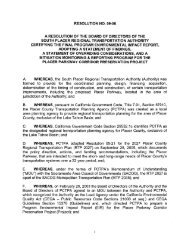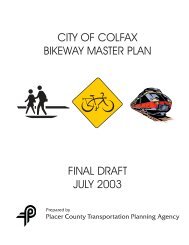Bus Rapid Transit (BRT) Implementation Study for South ... - pctpa
Bus Rapid Transit (BRT) Implementation Study for South ... - pctpa
Bus Rapid Transit (BRT) Implementation Study for South ... - pctpa
You also want an ePaper? Increase the reach of your titles
YUMPU automatically turns print PDFs into web optimized ePapers that Google loves.
<strong>Bus</strong> <strong>Rapid</strong> <strong>Transit</strong> (<strong>BRT</strong>) <strong>Implementation</strong> <strong>Study</strong> <strong>for</strong> south Placer CountySeptember 8, 2006On the other hand, the conditions at the employment end may be different. Cervero concluded in anotherstudy (1989) that suburban employment centers (SECs) with significant retail exhibited a 3 percent increasein transit/ridesharing use with every 10 percent increase in retail uses in the SEC. The ability to accomplishmidday errands and convenience shopping without a car influences some commuters to take transit. (Seeabove <strong>for</strong> a discussion of employment density and bus/rail ridership).University UsesCertain types of land use are “special generators” with respect to producing transit ridership; college anduniversity campuses are excellent examples of a special transit generator. Most university communities havehigher transit ridership compared to other land uses and good transit station access by vehicles, bicycles, andpedestrians. A comparison by Balsas (2003) found that the average level of transit use at eight universitycampuses was more than five times as high as transit ridership in the general population as revealed by the1995 NPTS.While high levels of transit use at university campuses has been documented extensively (e.g., Toor andHavlick, 2004), and programs to promote transit at universities have also been closely tracked (e.g., Brown,Hess and Shoup, 2001) few, if any, studies have attempted to directly model the effect of a nearby collegecampus on LRT or <strong>BRT</strong> ridership. Fehr & Peers’ ongoing research on LRT ridership in Sacramento, SaltLake City, and elsewhere may provide additional data and tools <strong>for</strong> estimating the university effect in the nearfuture, but in<strong>for</strong>mation to date is limited to analogue comparisons.Land Use Thresholds to Support <strong>Transit</strong>A variety of sources recommend residential densities of at least 4 dwelling units per acre or more <strong>for</strong> minimal(bus) transit service to be viable (Pusharkev & Zupan, 1983; ITE, 1989). Another study stated that 7 to 15dwelling units per acre can support local bus service (USDOT/Snohomish County Transportation Authority,1989). Pushkarev and Zupan (1977) examined this question thoroughly in the 1970s; their key conclusionsregarding density thresholds <strong>for</strong> various modes of transit are shown in Table 4. Pushkarev and Zupan’scriteria have been used regularly, and have generally been substantiated by other research.Two important caveats regarding Pushkarev and Zupan study are listed below.• The study is 25 years old, and much of the data is older.• Much of Pushkarev and Zupan’s data was drawn from the New York region, which, particularly in the1970s, had a bias toward transit use, while all other factors held equal.The level of auto-ownership and auto-oriented development in south Placer County in 2004 means that thereis considerably less tendency to use transit compared to the New York region. Thus while the land usethresholds <strong>for</strong> various types of transit developed by Pushkarev and Zupan are still valid, they should generallybe viewed as absolute minimum thresholds in auto-oriented regions.20





